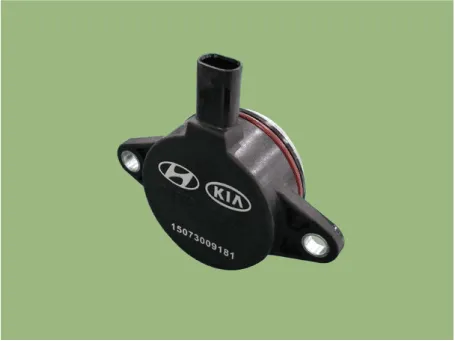Hyundai Palisade (LX2): Engine Control System / Variable Force Solenoid (VFS)
Description and operation
Continuous Variable Valve Timing (CVVT) system advances or retards the valve
timing of the intake and exhaust valve in accordance with the ECM control signal
which is calculated by the engine speed and load. By controlling CVVT, the valve
overlap or underlap occurs, which in turn improves fuel efficiency, reduces
exhaust gases (NOx, HC) and improves engine performance by reducing pumping
loss, generating internal EGR effect, improving combustion stability, improving
volumetric efficiency and increasing expansion work. This system consists of
the Variable Force Solenoid (VFS) which supplies the engine oil to the cam phaser
or cuts the engine oil from the cam phaser in accordance with the ECM PWM (Pulse
With Modulation) control signal, the Cam Phaser which varies the cam phase by
using the hydraulic force of the engine oil.
Variable force solenoid (VFS) [intake] changes its force depending on the PWM
duty to control the stroke of the CVVT oil control valve (OCV) [intake] bolt.
The delivered oil rotates the rotor connected to the camshaft of the cam pager
and rotates the camshaft to the engine rotating direction (intake advanced /
exhaust retarded) or the opposite direction (intake retarded / exhaust advanced)
to change the phase angle of the cam.
Variable Force Solenoid (VFS) [Banks 1, 2/Intake]

Specifications
Item
|
Specification
|
Coil Resistance (Ω)
|
7.0 - 8.0 [20°C (68°F)]
|
Repair procedures
| 1. |
Switch "OFF" the ignition.
|
| 2. |
Disconnect the VFS connector.
|
| 3. |
Measure resistance between the VFS terminals 1 and 2.
|
| 4. |
Check that the resistance is within the specification.
|
Specification : 7.0 - 8.0Ω [20°C (68°F)]
|
|
Variable Force Solenoid (VFS) [Bank 1 / Intake]
| 1. |
Switch "OFF" the ignition and disconnect the negative (-) battery terminal.
|
| 2. |
Disconnect the VFS connector (A).
|
| 3. |
Remove the mounting bolts (B), and then remove the VFS from the engine.
|
Variable force solenoid mounting bolt :
9.8 - 11.8 N.m (1.0 - 1.2 kgf.m, 7.2 - 8.7 lb-ft)
|

|
Variable Force Solenoid (VFS) [Bank 2 / Intake]
| 1. |
Switch "OFF" the ignition and disconnect the negative (-) battery terminal.
|
| 2. |
Disconnect the VFS connector (A).
|
| 3. |
Remove the mounting bolts (B), and then remove the VFS from the engine.
|
Variable force solenoid mounting bolt :
9.8 - 11.8 N.m (1.0 - 1.2 kgf.m, 7.2 - 8.7 lb-ft)
|

|
| • |
Install the component to the specified torque.
|
| • |
Note that internal damage may occur when the component is dropped.
If the component has been dropped, inspect before installing.
|
|
| 1. |
Install in the reverse order of removal.
|
Description and operation
Description
Installed on the intake manifold, the Purge Control Solenoid Valve (PCSV) controls
the evaporative purge between the canister and the intake manifold.
Description and operation
Description
Continuous Variable Valve Timing (CVVT) system advances or retards the valve
timing of the intake and exhaust valve in accordance with the ECM control signal
which is calculated by the engine speed and load.
Other information:
Repair procedures
Removal
1.
Disconnect the negative (-) battery terminal.
2.
Remove the crash pad lower panel.
(Refer to Body - "Crash Pad Lower Panel")
3.
Inspection
Tolerance Compensation
Tolerance compensation compensates for the error margins of around view video
that occur due to the installation tolerance when the four cameras that comprise
the SVM system are installed.
You must carry out tolerance compensation if you do any of the following.




